System Dynamics Modeling for Estimating the Locations of Road Icing Using GIS
Abstract
:1. Introduction
- Factors
- Factors that affect road icing are mainly divided into spatial and meteorological data. Hillshade is the factor that represents spatial information and is calculated by DEM [10,11]. This factor accelerates road icing by preventing solar radiation from reaching the ground [12,13]. The main factor of meteorological data is precipitation. In particular, the freezing rain phenomenon instantaneously accelerates road icing and causes accidents [14].
- Methods
- System dynamics is a method of simulating a certain phenomenon by connecting block diagrams based on causality. In particular, it is strong in time-series expressions that are difficult to estimate for humans, while road icing is a phenomenon that continue to vary over time [15].
- Study Contributions
- The existing case studies are not complete. GIS simulation is particularly insufficient. This study addressed this insufficiency and is described later in detail.
- Lee et al. performed numerical modeling related to road icing in Jeju Island, Korea. They estimated the air temperature and wind speed through the WRF model, but estimation of the accurate amount and location of road icing is insufficient [19].
- Kangas, Heikinheimo, and Hippi performed numerical modeling on factors related to road icing. They estimated the road surface condition and traffic condition by estimating road surface temperature, storage, and friction through the NWP model [20]. Estimation of the accurate amount and location of road icing is insufficient.
- Bezrukova, Stulov, and Khalili performed numerical modeling to estimate the occurrence of road icing. They developed a block diagram model to estimate the Ice Index through the road surface temperature, air temperature, and humidity. They could simply estimate the occurrence of road icing, and estimation of the amount and location of road icing is insufficient [21].
- Chapman, Thornes, and Bradley estimated the road surface temperature through numerical modeling from parameters. They analyzed the relationships between the “latitude, altitude, sky-view factor, screening, roughness length, road construction, traffic density, and topography” with the road surface temperature. Estimation of the accurate amount and location of road icing is insufficient [22].
- Park, Joo, and Son developed a model capable of estimating the road surface temperature by combining the Unified Model of the Korean Meteorological Administration (KMA) and the physical characteristics of the road surface. Although it is possible to estimate the road surface temperature with various factors, estimation of the amount and location of road icing is not sufficient [23].
- In other studies, road icing or related factors were also estimated mainly through simple numerical modeling. Road icing was estimated by analyzing heat conduction through the air temperature and humidity [24], measuring and analyzing road surface salinity and temperature [25], and developing short-term road icing estimation algorithms for sensors [26,27]. As in the above cases, however, estimation of the amount and location of road icing is insufficient.
2. Materials and Methods
2.1. Location of Study Area
2.2. Acquisition of Study Data
2.3. Scenario Selection
2.4. Modeling Road Icing
2.4.1. Road Temperature
2.4.2. Road Moisture
- Case (1) when water is collected on a road by precipitation (Precipitation)
- Case (2) when water vapor condenses on a road as the road temperature drops below the dew point (Condensation)
2.4.3. Road Icing
2.5. GIS Simulation of Road Icing
3. Results
3.1. Modeling Results for Road Temperature and Moisture
3.2. Modeling and Simulation Results for Road Icing
4. Discussion
- H0: (null hypothesis) the model does not generate thin ice in the vulnerable area (RI < 3 g/m3).
- H1: (alternative hypothesis) the model generates thin ice in the vulnerable area (RI >= 3 g/m3).
5. Conclusions
Author Contributions
Funding
Institutional Review Board Statement
Informed Consent Statement
Data Availability Statement
Conflicts of Interest
Appendix A
| Number | Name | Definition |
|---|---|---|
| 1 | RMSE ASOS | SQRT(RUNSUM((‘Actual Road Temperature’[18583] − ’Estimated Road Temperature’[18583])^2)/14) |
| 2 | RMSE | SQRT(RUNSUM((‘Actual Road Temperature’ − ’Estimated Road Temperature’)^2)/14) |
| 3 | Condensation | MAX(0, Atmospheric Moisture_1m above- Saturated Water Vapor _Road) |
| 4 | Road Moisture | MAX(0,RUNSUM(Condensation + Mass_Preci-Fr_Delay)) |
| 5 | Lake Evaporation per Hour (mm) | MAX(0,(0.345*(‘ Saturated Vapor Pressure_Air_mmhg’ − ’ Vapor Pressure _Air_mmhg’)*(0.5 + 0.54*’Wind Speed’))/24) |
| 6 | Freezing | IF(‘Road Moisture’ < 0,0,1)*IF(Precipitation>0,’Road Moisture’*IF(‘Road Temp’<=1,MIN(1,(−1*’Road Temp’ + 1)/5),0),’Road Moisture’*IF(‘Road Temp’<=0,MIN(1,(−1*’Road Temp’ + 1)/5),0))//IF(‘Road Moisture’ < 0,0,1)*IF(Precipitation > 0,’Road Moisture’*IF(‘Road Temp’ < 1,1,0),’Road Moisture’*IF(‘Road Temp’ < 0,1,0)) |
| 7 | Thawing | IF(‘Air Temp’ > 0,’Freezing Road’*(Hillshade/254),0) |
| 8 | MAPE | FOR(i = 1..18583|RUNSUM(ABS( (‘Actual Road Temperature_Nor’ [i] − ’Estimated Road Temperature_Nor’ [i])/(‘Estimated Road Temperature_Nor’ [i]))/14))*100% |
| 9 | Mass of Precipitation | FOR(i = 1..18583|RANDOM (0.98, 1.02, 0.5/i)) * (100*100*Precipitation*0.1) |
| 10 | Road Temperature | FOR(i = 1..18583|RANDOM (0.98, 1.02, 0.5/i)) * (‘Air Temp’*’Weigh_Air Temp’ + Weight_Hillshade*Hillshade*(((‘Cloudy’-10)* − 1)*’Weight_Cloudy’) + Weight_Bridge*Loacation_Bridge + Constant) |
| 11 | Saturated Vapor Pressure (Road) | 6.1078*10^(7.5*’Road Temp’/(‘Road Temp’ + 237.3)) |
| 12 | Saturated Vapor Pressure (Air) | 6.1078*10^(7.5*’Air Temp’/(‘Air Temp’ + 237.3)) |
| 13 | Saturated Water Vapor (Air) | 217*(‘Saturated Vapor Pressure _Air’/(‘Air Temp’ + 273.15)) |
| 14 | Saturated Water Vapor (Road) | 217*(‘Saturated Vapor Pressure _Road’/(‘Road Temp’ + 273.15)) |
| 15 | Atmospheric Moisture (1m above) | 217*(‘Vapor Pressure’/(‘Air Temp’ + 273.15)) + ‘Evaporation g per m3’ |
| 16 | Evaporation (g/m3) | 100*100*’ Lake Evaporation per Hour _mm’*0.1*’River Sys’ |
| 17 | Weight_Bridge | −1 − (1*(TIME/13))//−(((TIME+3)/16)*2)// //IF(TIME<9,−1,IF(TIME<14,−2,0)) |
| 18 | Relative Humidity | (‘Vapor Pressure’/ ‘Saturated Vapor Pressure’)*100 |
Appendix B
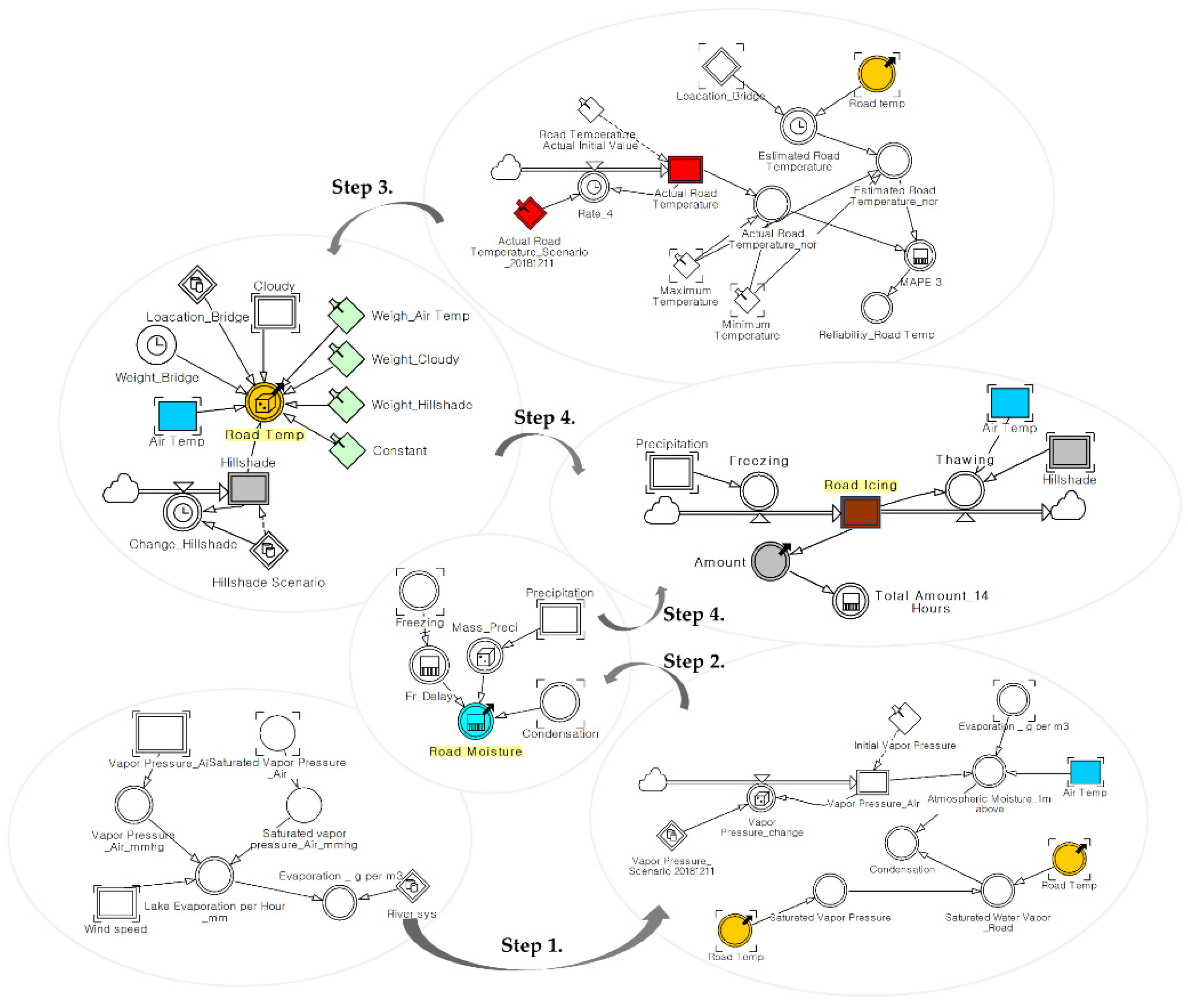
References
- Cary, L. Black Ice; Vintage: New York, NY, USA, 2010. [Google Scholar]
- Lee, S.J. Traffic Accident Article (Case1). Available online: http://news.tvchosun.com/site/data/html_dir/2020/01/06/2020010690068.html (accessed on 6 January 2020).
- Jung, S.H. Traffic Accident Article (Case2). Available online: http://www.joynews24.com/view/1231389 (accessed on 26 December 2019).
- Kim, M.I. Traffic Accident Article (Case3). Available online: https://www.segye.com/newsView/20191129511652?OutUrl=naver (accessed on 29 November 2019).
- Authority, R.T. Traffic Accident Analysis System. Available online: http://taas.koroad.or.kr/web/shp/adi/initBasisPurps.do?menuId=WEB_KMP_IID_IID_PAB (accessed on 1 January 2020).
- Jones, K.; Eylander, J. Vertical variation of ice loads from freezing rain. Cold Reg. Sci. Technol. 2017, 143, 126–136. [Google Scholar] [CrossRef]
- Yan, Q.; Li, B.; Zhang, Y.; Yan, J.; Zhang, C. Numerical Investigation of Heat-Insulating Layers in a Cold Region Tunnel, Taking into Account Airflow and Heat Transfer. Appl. Sci. 2017, 7, 679. [Google Scholar] [CrossRef] [Green Version]
- Qiu, P.; Li, P.; Hu, J.; Liu, Y. Modeling Seepage Flow and Spatial Variability of Soil Thermal Conductivity during Artificial Ground Freezing for Tunnel Excavation. Appl. Sci. 2021, 11, 6275. [Google Scholar] [CrossRef]
- Kim, C.H. System Dynamics; pybook: Seoul, Korea, 2021. [Google Scholar]
- Choi, B.-G.; Kim, J.-S. Extraction of road surface freezing section using GIS. J. Korean Soc. Geospat. Inf. Syst. 2005, 13, 19–25. [Google Scholar]
- Lee, H.S. Analyses on sunshine influence and surface freezing section of road using GIS. J. Korean Soc. Surv. Geod. Photogramm. Cartogr. 2005, 23, 293–301. [Google Scholar]
- Del Vecchio, M.C.; Ceppi, A.; Corbari, C.; Ravazzani, G.; Mancini, M.; Spada, F.; Maggioni, E.; Perotto, A.; Salerno, R. A Study of an Algorithm for the Surface Temperature Forecast: From Road Ice Risk to Farmland Application. Appl. Sci. 2020, 10, 4952. [Google Scholar] [CrossRef]
- Mirzanamadi, R.; Hagentoft, C.-E.; Johansson, P. Numerical Investigation of Harvesting Solar Energy and Anti-Icing Road Surfaces Using a Hydronic Heating Pavement and Borehole Thermal Energy Storage. Energies 2018, 11, 3443. [Google Scholar] [CrossRef] [Green Version]
- Toms, B.A.; Basara, J.B.; Hong, Y. Usage of Existing Meteorological Data Networks for Parameterized Road Ice Formation Modeling. J. Appl. Meteorol. Climatol. 2017, 56, 1959–1976. [Google Scholar] [CrossRef]
- Sterman, J. Business Dynamics; McGrawHill: New York, NY, USA, 2000. [Google Scholar]
- Liu, T.; Wang, N.; Yu, H.; Basara, J.; Hong, Y.E.; Bukkapatnam, S. Black Ice Detection and Road Closure Control System for Oklahoma (Fhwa-Ok-14-01 2239). Oklahoma Department of Transportation: Oklahoma City, OK, USA, 2014. [Google Scholar]
- Li, S.; Xiong, C.; Ou, Z. A Web GIS for sea ice information and an ice service archive. Trans. GIS 2011, 15, 189–211. [Google Scholar] [CrossRef]
- Liu, T.; Pan, Q.; Sanchez, J.; Sun, S.; Wang, N.; Yu, H. Prototype Decision Support System for Black Ice Detection and Road Closure Control. IEEE Intell. Transp. Syst. Mag. 2017, 9, 91–102. [Google Scholar] [CrossRef]
- Lee, Y.-M.; Oh, S.-Y.; Lee, S.-J. A study on prediction of road freezing in Jeju. J. Environ. Sci. Int. 2018, 27, 531–541. [Google Scholar] [CrossRef]
- Kangas, M.; Heikinheimo, M.; Hippi, M. RoadSurf: A modelling system for predicting road weather and road surface conditions. Meteorol. Appl. 2015, 22, 544–553. [Google Scholar] [CrossRef]
- Bezrukova, N.; Stulov, E.; Khalili, M. A model for road icing forecast and control. In Proceedings of the Proceedings SIRWEC, Turin, Italy, 25–27 March 2006; pp. 50–57. [Google Scholar]
- Chapman, L.; Thornes, J.E.; Bradley, A.V. Modelling of road surface temperature from a geographical parameter database. Part 2: Numerical. Meteorol. Appl. 2001, 8, 421–436. [Google Scholar] [CrossRef]
- Park, M.-S.; Joo, S.J.; Son, Y.T. Development of road surface temperature prediction model using the Unified Model output (UM-Road). Atmosphere 2014, 24, 471–479. [Google Scholar] [CrossRef] [Green Version]
- Sass, B.H. A Numerical Model for Prediction of Road Temperature and Ice. J. Appl. Meteorol. 1992, 31, 1499–1506. [Google Scholar] [CrossRef] [Green Version]
- Xu, H.; Zheng, J.; Li, P.; Wang, Q. Road icing forecasting and detecting system. In AIP Conference Proceedings; AIP Publishing LLC: Melville, NY, USA, 2017; p. 020089. [Google Scholar]
- Troiano, A.; Pasero, E.; Mesin, L. New system for detecting road ice formation. IEEE Trans. Instrum. Meas. 2010, 60, 1091–1101. [Google Scholar] [CrossRef] [Green Version]
- Teke, M.; Duran, F. The design and implementation of road condition warning system for drivers. Meas. Control 2019, 52, 985–994. [Google Scholar] [CrossRef] [Green Version]
- Wilson, D. Using machine learning to predict car accident risk. Proc. Medium-Geospat. Artif. Intell. 2018. [Google Scholar]
- Shao, J.; Lister, P. The prediction of road surface state and simulation of the shading effect. Bound.—Layer Meteorol. 1995, 73, 411–419. [Google Scholar] [CrossRef]
- Dyras, I.; Serafin-Rek, D. The application of GIS technology for precipitation mapping. Meteorol. Appl. 2005, 12, 69–75. [Google Scholar] [CrossRef]
- Brini, I.; Alexakis, D.D.; Kalaitzidis, C. Linking Soil Erosion Modeling to Landscape Patterns and Geomorphometry: An Application in Crete, Greece. Appl. Sci. 2021, 11, 5684. [Google Scholar] [CrossRef]
- Shin, Y.; Choi, J.C.; Quinteros, S.; Svendsen, I.; L’Heureux, J.-S.; Seong, J. Evaluation and Monitoring of Slope Stability in Cold Region: Case Study of Man-Made Slope at Øysand, Norway. Appl. Sci. 2020, 10, 4136. [Google Scholar] [CrossRef]
- Liu, H.; Wang, X.; Liao, X.; Sun, J.; Zhang, S. Rockfall Investigation and Hazard Assessment from Nang County to Jiacha County in Tibet. Appl. Sci. 2019, 10, 247. [Google Scholar] [CrossRef] [Green Version]
- Mousavi Tayebi, S.A.; Moussavi Tayyebi, S.; Pastor, M. Depth-Integrated Two-Phase Modeling of Two Real Cases: A Comparison between r.avaflow and GeoFlow-SPH Codes. Appl. Sci. 2021, 11, 5751. [Google Scholar] [CrossRef]
- Liu, B.; Lv, Y.; Guo, Z. A Study of Road Surface Ice Prediction Based on Highway Operations and Safety. In ICTIS 2013: Improving Multimodal Transportation Systems-Information, Safety, and Integration, Proceedings of the Second International Conference on Transportation Information and Safety, Wuhan, China, 29 June 29–2 July 2013; American Society of Civil Engineers: Reston, VA, USA, 2013; pp. 1244–1250. [Google Scholar]
- Zerr, R.J. Freezing rain: An observational and theoretical study. J. Appl. Meteorol. 1997, 36, 1647–1661. [Google Scholar] [CrossRef]
- Almoshaogeh, M.; Abdulrehman, R.; Haider, H.; Alharbi, F.; Jamal, A.; Alarifi, S.; Shafiquzzaman, M. Traffic Accident Risk Assessment Framework for Qassim, Saudi Arabia: Evaluating the Impact of Speed Cameras. Appl. Sci. 2021, 11, 6682. [Google Scholar] [CrossRef]
- Kang, J.-E.; Kim, J.-J. Assessment of Observation Environments of Automated Synoptic Observing Systems Using GIS and WMO Meteorological Observation Guidelines. Korean J. Remote Sens. 2020, 36, 693–706. [Google Scholar]
- Administration, K.M. KMA Weather Data Service—Open MET Data Portal. Available online: https://data.kma.go.kr/cmmn/main.do (accessed on 11 December 2020).
- Salimi, S.; Nassiri, S.; Bayat, A.; Halliday, D. Lateral coefficient of friction for characterizing winter road conditions. Can. J. Civ. Eng. 2016, 43, 73–83. [Google Scholar] [CrossRef]
- Park, K.; Kim, Y.; Lee, K.; Kim, D. Development of a Shallow-Depth Soil Temperature Estimation Model Based on Air Temperatures and Soil Water Contents in a Permafrost Area. Appl. Sci. 2020, 10, 1058. [Google Scholar] [CrossRef] [Green Version]
- Holland, J.H. Genetic algorithms and adaptation. In Adaptive Control of Ill-Defined Systems; Springer: Berlin/Heidelberg, Germany, 1984; pp. 317–333. [Google Scholar]
- Lin, C.-M.; Liu, H.-Y.; Tseng, K.-Y.; Lin, S.-F. Heating, Ventilation, and Air Conditioning System Optimization Control Strategy Involving Fan Coil Unit Temperature Control. Appl. Sci. 2019, 9, 2391. [Google Scholar] [CrossRef] [Green Version]
- Zhang, L.; Li, C.; Wu, Y.; Zhang, K.; Shi, H. Hybrid Prediction Model of the Temperature Field of a Motorized Spindle. Appl. Sci. 2017, 7, 1091. [Google Scholar] [CrossRef] [Green Version]
- Ge, Z.; Li, J.; Duan, Y.; Yang, Z.; Xie, Z. Thermodynamic Performance Analyses and Optimization of Dual-Loop Organic Rankine Cycles for Internal Combustion Engine Waste Heat Recovery. Appl. Sci. 2019, 9, 680. [Google Scholar] [CrossRef] [Green Version]
- Gorni, D.; Visioli, A. Genetic Algorithms Based Reference Signal Determination for Temperature Control of Residential Buildings. Appl. Sci. 2018, 8, 2129. [Google Scholar] [CrossRef] [Green Version]
- Karlsson, M. Prediction of hoar-frost by use of a Road Weather Information System. Meteorol. Appl. 2001, 8, 95–105. [Google Scholar] [CrossRef]
- Silberberg, M.S.M.S. Chemistry: The Molecular Nature of Matter and Change; McGraw-Hill: Boston, MA, USA, 2009. [Google Scholar]
- Bejan, A. Advanced Engineering Thermodynamics; John Wiley & Sons: Hoboken, NJ, USA, 2016. [Google Scholar]
- Ishida, T.; Pen, K.; Tanaka, Y.; Kashimura, K.; Iwaki, I. Numerical Simulation of Early Age Cracking of Reinforced Concrete Bridge Decks with a Full-3D Multiscale and Multi-Chemo-Physical Integrated Analysis. Appl. Sci. 2018, 8, 394. [Google Scholar] [CrossRef] [Green Version]
- Pradhan, N.R.; Downer, C.W.; Marchenko, S. Catchment Hydrological Modeling with Soil Thermal Dynamics during Seasonal Freeze-Thaw Cycles. Water 2019, 11, 116. [Google Scholar] [CrossRef] [Green Version]
- Bonanno, R.; Loglisci, N.; Cavalletto, S.; Cassardo, C. Analysis of Different Freezing/Thawing Parameterizations using the UTOPIA Model. Water 2010, 2, 468–483. [Google Scholar] [CrossRef] [Green Version]
- World_Imagery. Available online: https://services.arcgisonline.com/ArcGIS/rest/services/World_Imagery/MapServer (accessed on 20 January 2020).
- Corporation, K.E. A supplementary management card for the ice vulnerability management section (management chart, May 22, 2020). 2020. [Google Scholar]
- Hogg, R.V.; McKean, J.; Craig, A.T. Introduction to mathematical statistics; Pearson Education: London, UK, 2005. [Google Scholar]
- Raftery, A.E.; Gilks, W.; Richardson, S.; Spiegelhalter, D. Hypothesis testing and model. Markov Chain Monte Carlo Pract. 1995, 1, 165–187. [Google Scholar]


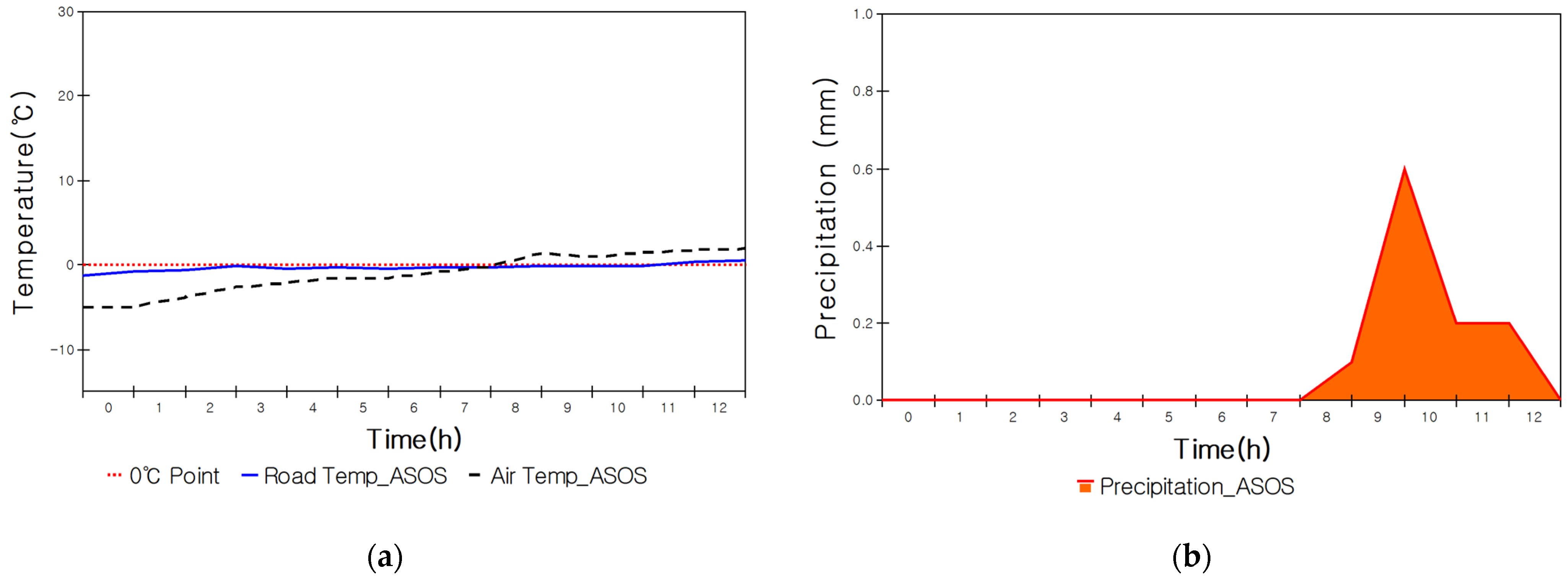

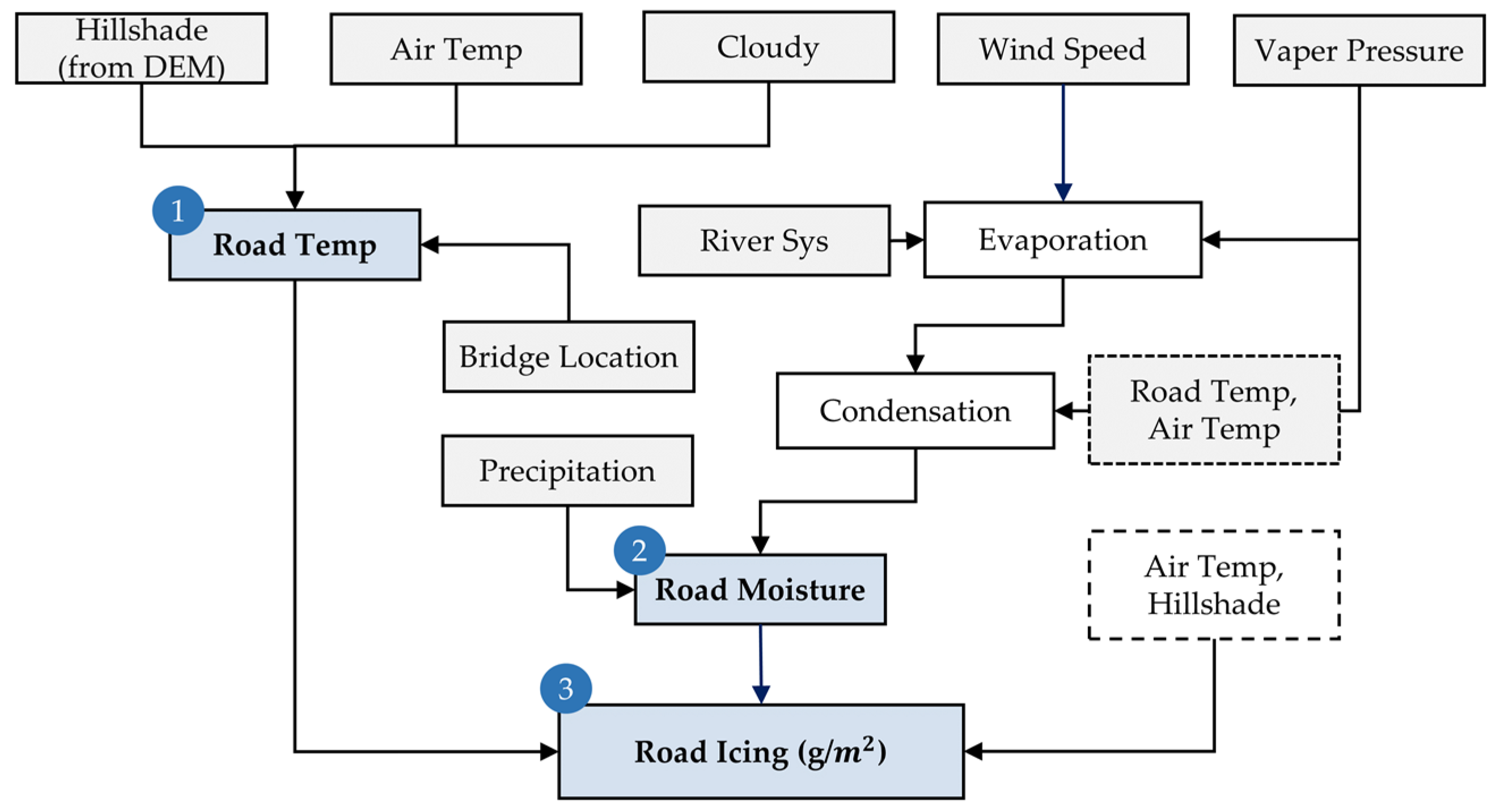
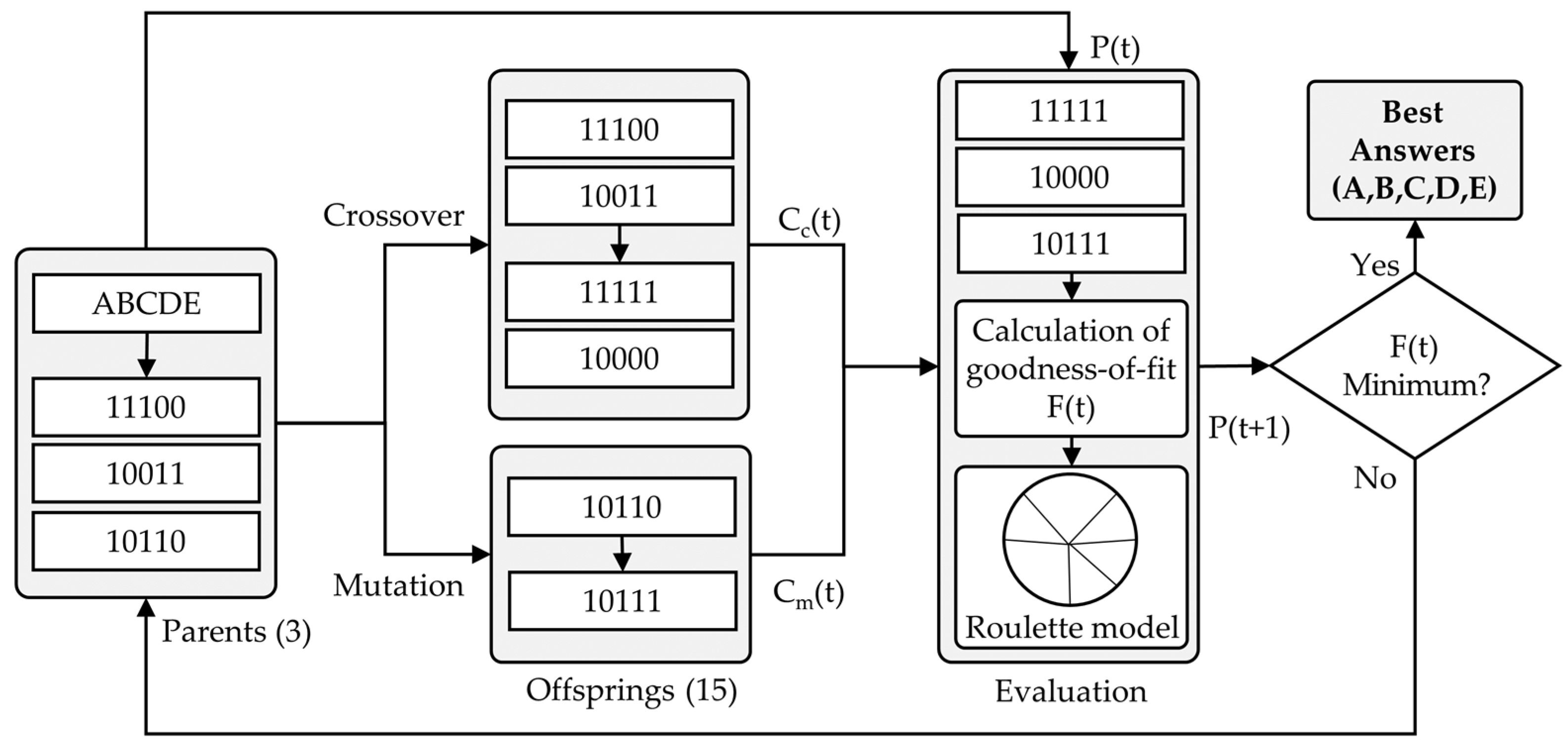
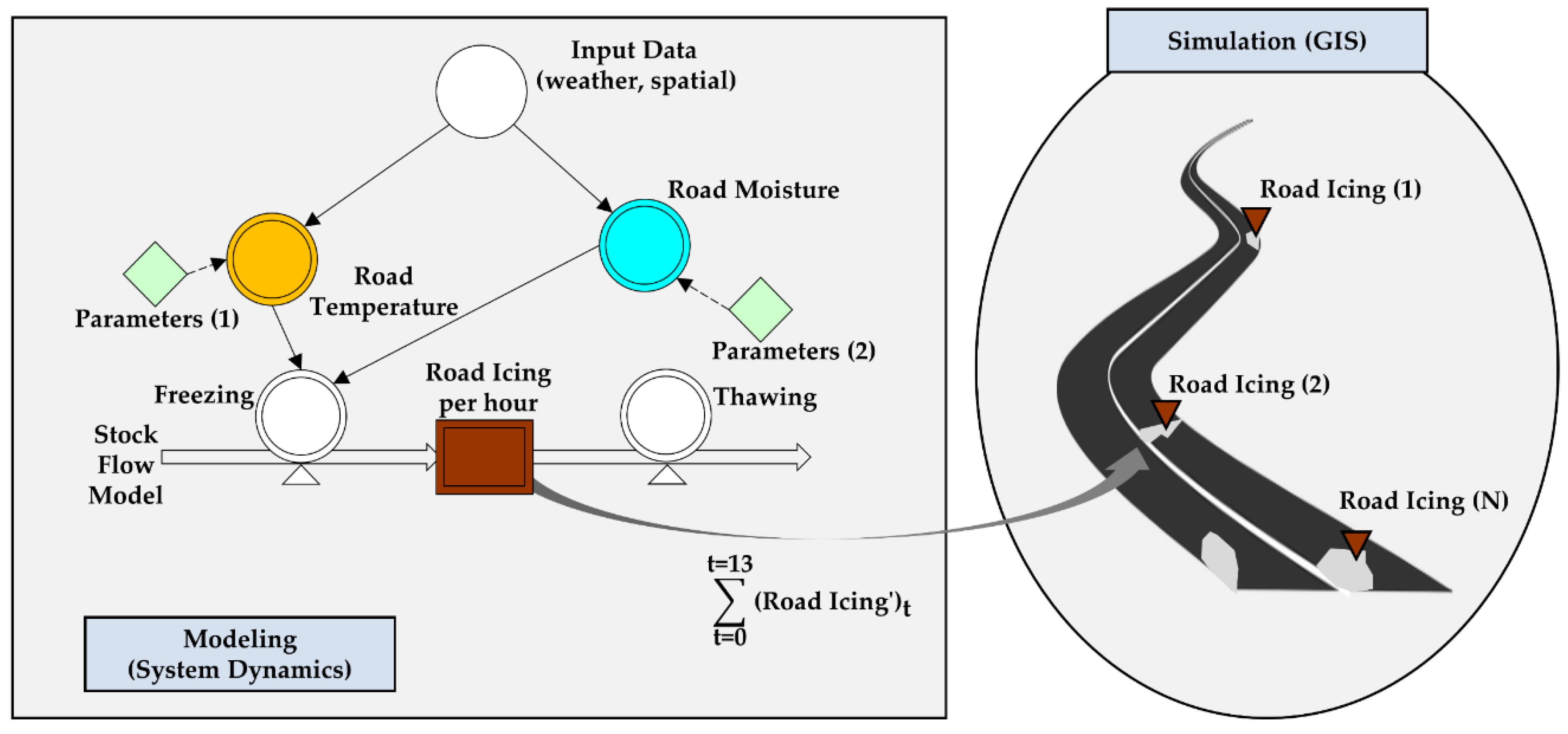
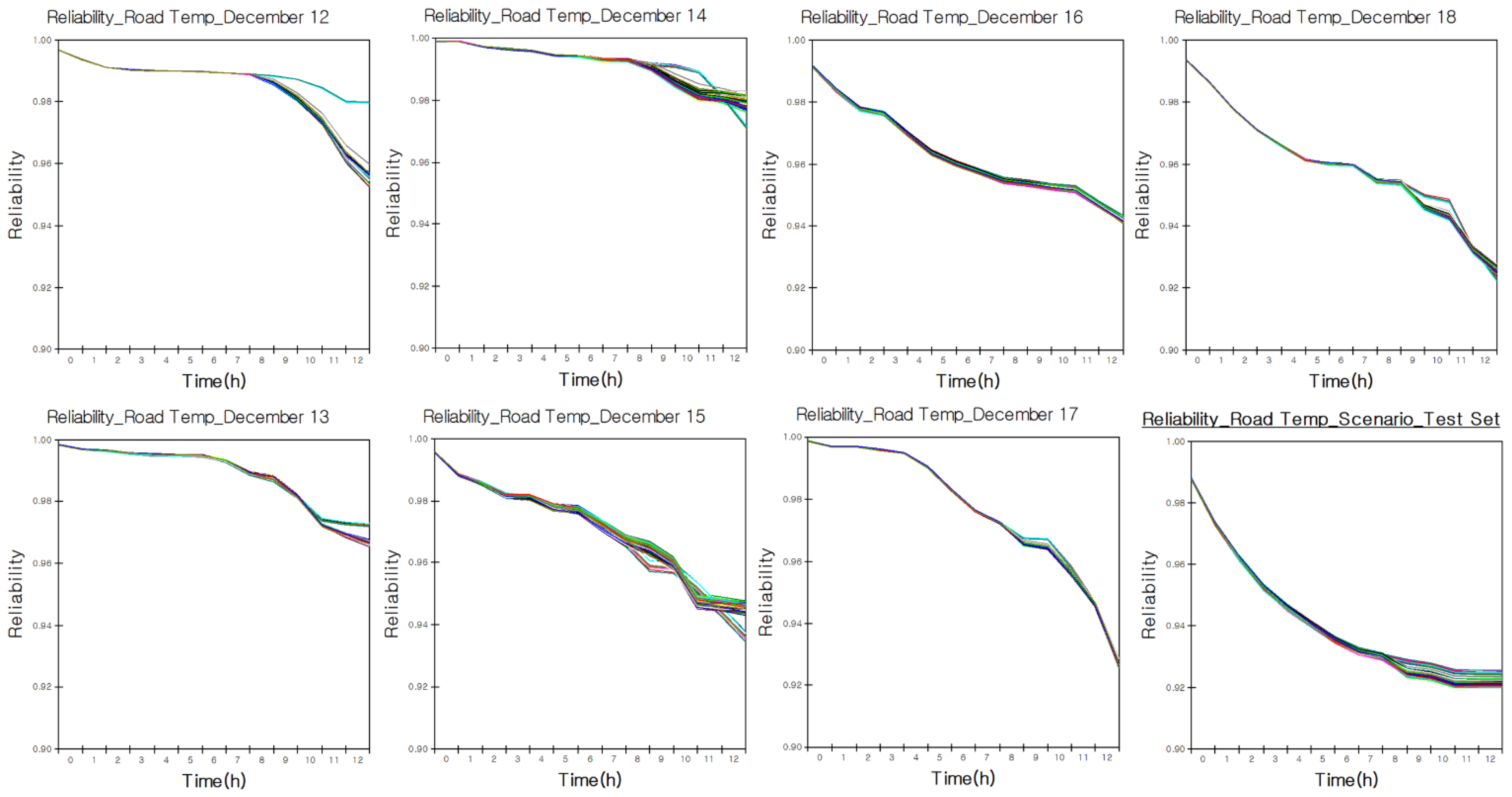

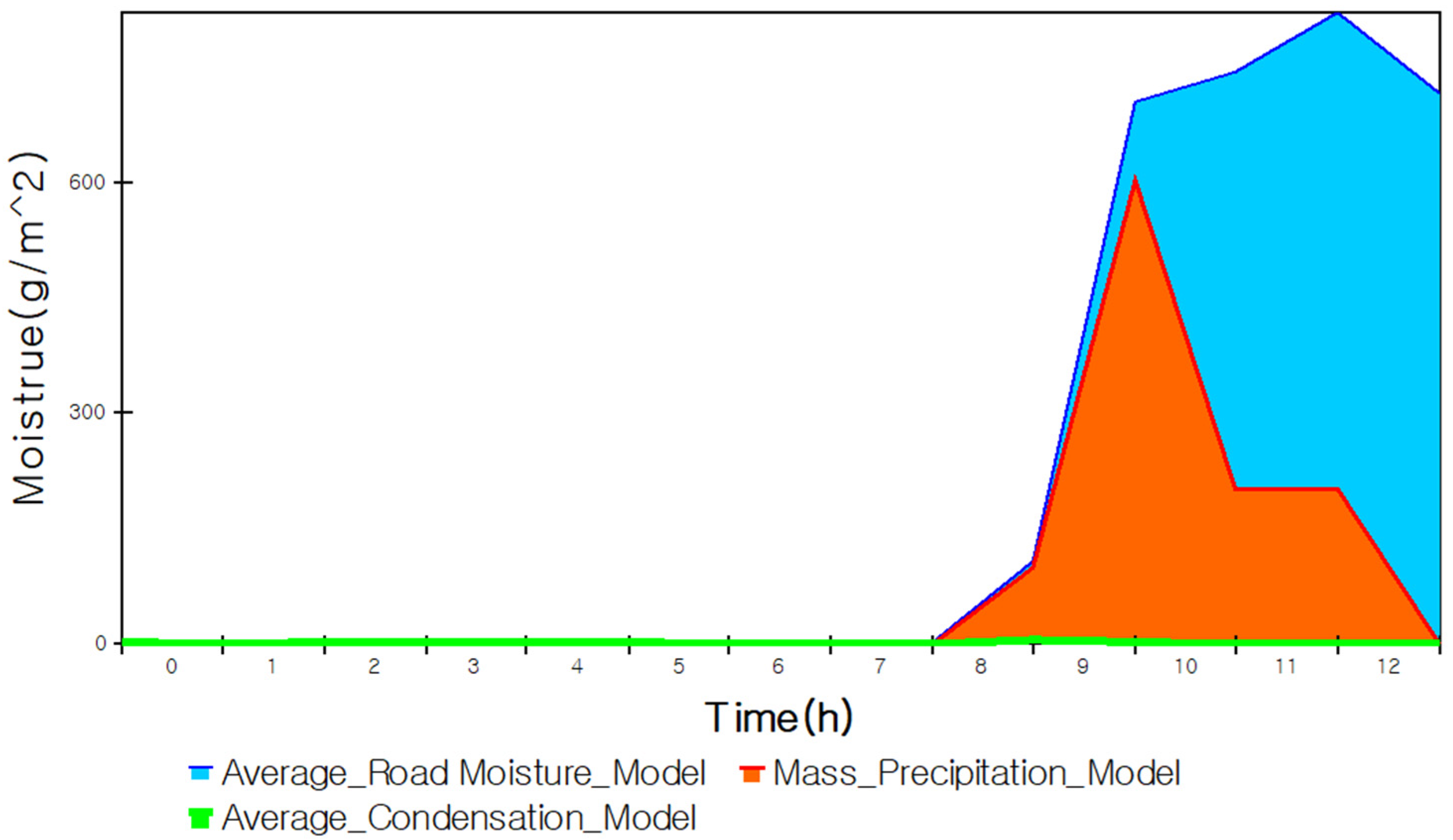

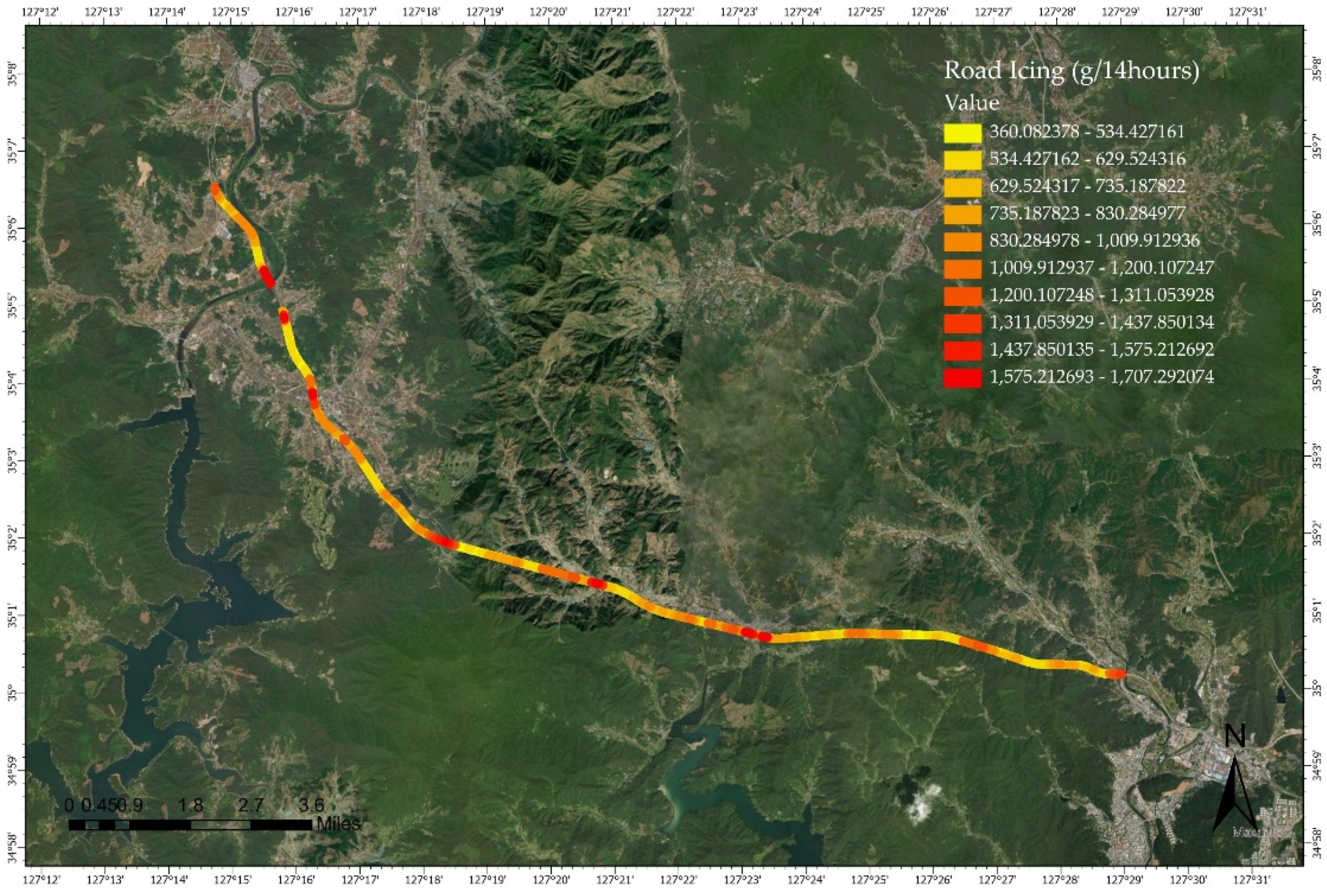
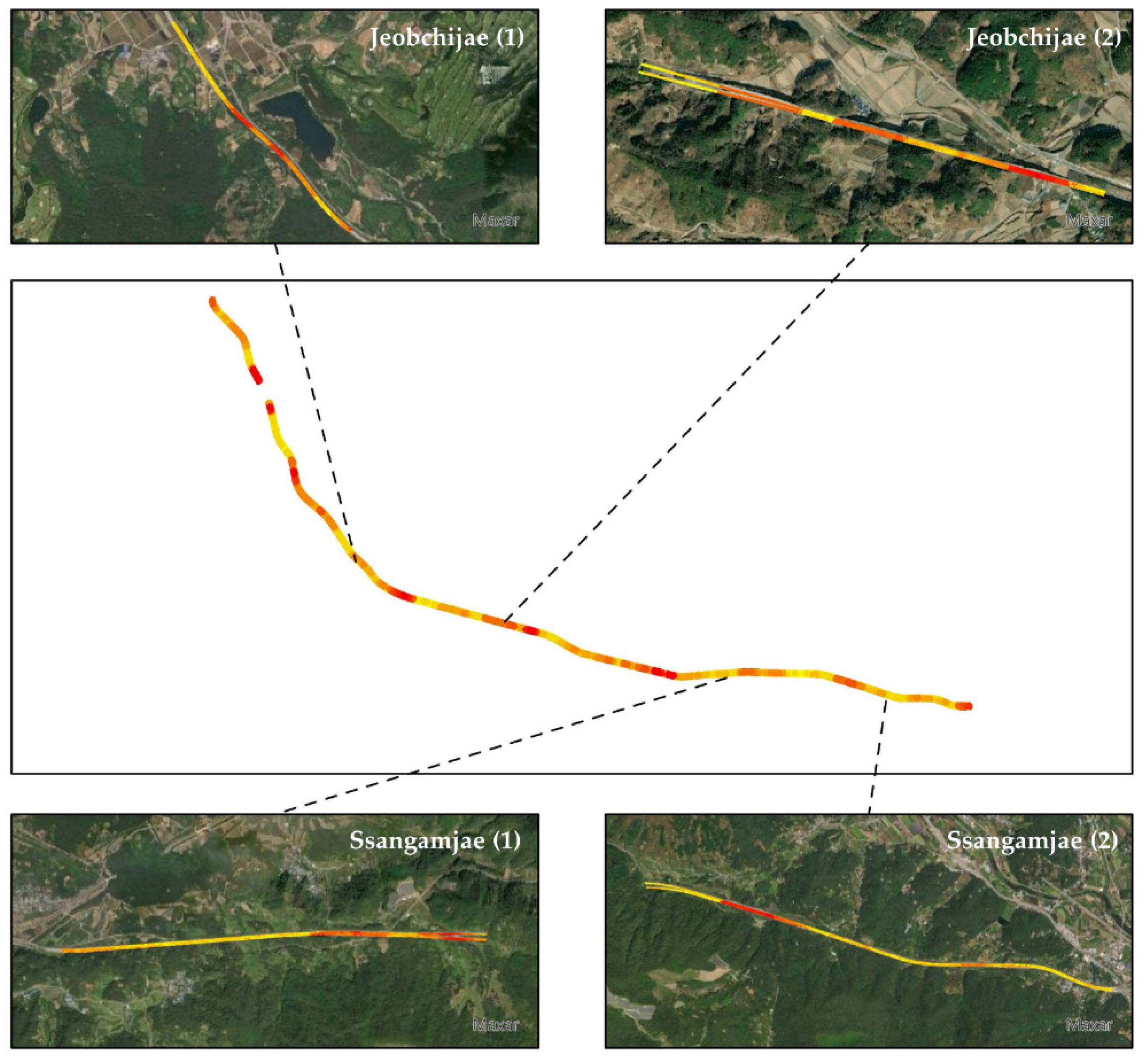
| Factor | Average | Unit | Implication | |
|---|---|---|---|---|
| Type of Analysis | Result | |||
| Minimum temperature | −2.0 | °C | Occurrence tendency | Occurs below 0 °C |
| Average cloud cover | 5.8 | - | Degree of occurrence | Five or more |
| Daily precipitation | 4.3 | mm/day | Occurrence/non-occurrence | Occurrence |
| Sunrise (time) | 07:28 | H:MM | Occurrence tendency | Faint sunlight |
| Accident (time) | 07:04 | H:MM | Occurrence tendency | Morning occurrence |
| Year | Average Summer Temperature (Suncheon, °C) | Average Summer Temperature (Jeollanam-do, °C) | Average Winter Temperature (Suncheon, °C) | Average Winter Temperature (Jeollanam-do, °C) | Annual Temperature Range (Suncheon, °C) |
|---|---|---|---|---|---|
| 2020 | 23.67 | 24.00 | 1.67 | 3.39 | 22.0 |
| 2019 | 23.07 | 23.63 | 3.05 | 4.87 | 20.0 |
| 2018 | 24.53 | 25.32 | 2.07 | 3.12 | 22.9 |
| 2017 | 24.23 | 24.60 | −0.50 | 1.17 | 24.7 |
| 2016 | 24.15 | 24.60 | 1.80 | 3.39 | 22.4 |
| 2015 | 23.17 | 23.25 | 2.20 | 3.40 | 21.0 |
| 2014 | 22.77 | 23.18 | 0.90 | 2.65 | 22.6 |
| 2013 | 24.73 | 25.16 | 1.83 | 3.22 | 23.4 |
| 2012 | 24.27 | 24.51 | −0.03 | 1.50 | 24.3 |
| 2011 | 24.03 | 24.00 | 0.13 | 1.34 | 23.9 |
| Data Name | Data Source | Resolution | Content |
|---|---|---|---|
| DEM | Lidar Satellite | 5 m (Interpolation, 1 m) | Hillshade formation |
| Hillshade | DEM | 1 m | Scenario input Evolution algorithm train set |
| River System | National Spatial Data Infrastructure Portal | 1 m | Scenario input |
| Road, Bridge | National Spatial Data Infrastructure Portal | 1 m | Scenario input |
| Data Name | Data Source | Range | Content |
|---|---|---|---|
| Air Temp | ASOS (Suncheon) | AM 00:00–PM 13:00 | Scenario input Evolution algorithm train set |
| Cloudy | ASOS (Suncheon) | AM 00:00–PM 13:00 | Scenario input Evolution algorithm train set |
| Vapor Pressure | ASOS (Suncheon) | AM 00:00–PM 13:00 | Scenario input |
| Wind Speed | ASOS (Suncheon) | AM 00:00–PM 13:00 | Scenario input |
| Precipitation | ASOS (Suncheon) | AM 00:00–PM 13:00 | Scenario input |
| Date | Road Surface Temperature | Air Temperature | Freezing Rain Occurrence Time | Precipitation Type |
|---|---|---|---|---|
| 2020/12/29 | Afternoon below 0 °C | Afternoon above 0 °C | PM 20:00~PM 21:00 | Freezing Rain |
| 2019/01/31 | Morning below 0 °C | Morning below 0 °C | AM 3:00~PM 15:00 | Snow |
| 2018/12/16 | Morning below 0 °C | Morning above 0 °C | AM 9:00~AM 15:00 | Freezing Rain |
| 2018/01/16 | Morning below 0 °C | Morning above 0 °C | AM 9:00~PM 12:00 | Freezing Rain |
| 2018/01/12 | Morning below 0 °C | Morning below 0 °C | AM 11:00~AM 12:00 | Snow |
| 2018/01/10 | Morning below 0 °C | Morning below 0 °C | AM 3:00~PM 18:00 | Snow |
| Factor | Category | Symbol | Value Range | Unit |
|---|---|---|---|---|
| Hillshade (from DEM) | Input (t = 0~13 h) Data | H | 0~254 | - |
| River System | RS | 0~1 | - | |
| Bridge Location | Lb | 0 or 1 | - | |
| Air Temp | Ta | −15~10 | °C | |
| Cloudy | Vc | 0~10 | - | |
| Vapor Pressure | Pv | 0 or more | Pa | |
| Wind Speed | Sw | 0 or more | m/s | |
| Precipitation | P | 0 or more | mm | |
| Evaporation | Intermediate (t = 0~13 h) | E | 0 or more | g/m3 |
| Condensation | C | 0 or more | g/m2 | |
| Road Temperature | Output (t = 0~13 h) | Tr | −15~10 | °C |
| Road Moisture | Mr | 0 or more | g/m2 | |
| Road Icing | RI | 0 or more | g/m2 |
| Case | Road Temperature | Road Moisture | Road Icing | GIS simulation | ||||
|---|---|---|---|---|---|---|---|---|
| Estimation | Form | Estimation | Form | Estimation | Form | Performance | Form | |
| Case ① [19] | √ | Occurrence/non-occurrence | – | – | – | – | – | – |
| Case ② [20] | √ | Value | – | Index | √ | Index | – | – |
| Case ③ [21] | √ | Value | – | Index | √ | Index | – | – |
| Case ④ [22] | √ | Value | – | – | – | – | – | – |
| Case ⑤ [23] | √ | Value | – | – | – | – | – | – |
| This study | √ | Value, location information | √ | Value, location information | √ | Value, location information | √ | GIS layer |
| Section Name | Management Number | Line | Freezing Accidents (Morning) | Regional Characteristics | Minimum Temperature |
|---|---|---|---|---|---|
| Jeobchijae (1) | 287 | Honam highway line 25 | 3 to 4 | Morning shading | −3~0 °C |
| Jeobchijae (2) | 288 | Honam highway line 25 | 1 to 2 | Morning shading | −3~0 °C |
| Ssangamjae (1) | 289 | Honam highway line 25 | 1 to 2 | Morning shading | −3~0 °C |
| Ssangamjae (2) | 290 | Honam highway line 25 | 1 to 2 | Morning shading | −3~0 °C |
| Section Name | Freezing Rain | Average Amount (Freezing Rain) | Z-Score | p-Value (One-Tailed) | Test Results |
|---|---|---|---|---|---|
| Jeobchijae (1) | AM9:00~PM12:00 | 135.77 (g/m2) | 13.61 | 0.000010 (<0.05) | H1 adoption |
| Jeobchijae (2) | AM9:00~PM12:00 | 208.37 (g/m2) | 2.01 | 0.022216 (<0.05) | H1 adoption |
| Ssangamjae (1) | AM9:00~PM12:00 | 142.56 (g/m2) | 8.23 | 0.000010 (<0.05) | H1 adoption |
| Ssangamjae (1) | AM9:00~PM12:00 | 152.81 (g/m2) | 2.08 | 0.018763 (<0.05) | H1 adoption |
Publisher’s Note: MDPI stays neutral with regard to jurisdictional claims in published maps and institutional affiliations. |
© 2021 by the authors. Licensee MDPI, Basel, Switzerland. This article is an open access article distributed under the terms and conditions of the Creative Commons Attribution (CC BY) license (https://creativecommons.org/licenses/by/4.0/).
Share and Cite
Hong, S.-B.; Lee, B.-W.; Kim, C.-H.; Yun, H.-S. System Dynamics Modeling for Estimating the Locations of Road Icing Using GIS. Appl. Sci. 2021, 11, 8537. https://doi.org/10.3390/app11188537
Hong S-B, Lee B-W, Kim C-H, Yun H-S. System Dynamics Modeling for Estimating the Locations of Road Icing Using GIS. Applied Sciences. 2021; 11(18):8537. https://doi.org/10.3390/app11188537
Chicago/Turabian StyleHong, Seok-Bum, Byung-Woong Lee, Chang-Hoon Kim, and Hong-Sik Yun. 2021. "System Dynamics Modeling for Estimating the Locations of Road Icing Using GIS" Applied Sciences 11, no. 18: 8537. https://doi.org/10.3390/app11188537
APA StyleHong, S.-B., Lee, B.-W., Kim, C.-H., & Yun, H.-S. (2021). System Dynamics Modeling for Estimating the Locations of Road Icing Using GIS. Applied Sciences, 11(18), 8537. https://doi.org/10.3390/app11188537






